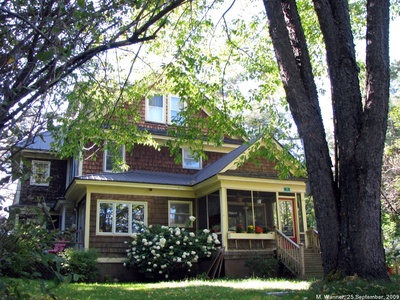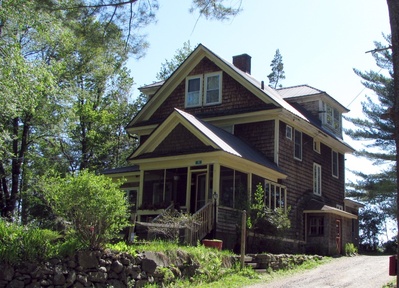 Adelaide Crapsey Cottage
Adelaide Crapsey Cottage  Adelaide Crapsey Cottage Address: 71 Clinton Avenue
Adelaide Crapsey Cottage Address: 71 Clinton Avenue
Old Address: 39 Clinton Avenue
Other names: Miss Lucy Cottage (1911), Dungar Cottage (1929); DIS
Year built: 1910
Built by: Branch and Callanan
Other information: Adelaide Crapsey (1878-1914) was a young woman, an instructor in poetics at Smith College, and a poet who invented the cinquain form. She cured — unsuccessfully — in this cottage in a room overlooking Pine Ridge Cemetery; she wrote perhaps her best-known poem here, "To the Dead in the Graveyard Underneath My Window." She returned home to Rochester where she died of T.B.
The cottage was run by Miss R. Helen Lucy.
In 2010, it is the home of Marsha and Steve Morgan, who purchased it from Poker Ryan in 1974 (father of Danny, David and Theresa Ryan). This home was known as the Miss Lucy Cottage.
Excerpt from Alone in the Dark by Karen Alkalay-Gut
Usually patients were placed with other patients in similar circumstances, with similar interests, age, and background so they could boost each other's spirits and contribute to each other's cure. Those placed in the large sanitorium were usually only mildly ill, and their chances of recovery and departure were great. The groups that would form in the smaller "cure cottages" were often close-knit and socially, soemtimes even romantically, active. For the most seriously ill, there were also "accommodations for private treatment at home" with private nurses. These cottages and private homes taking in patients were scattered about the town and the patients were more dependent on their nurses.
Once Dr. Jewett's diagnosis that Crapsey's case was "well established" was confirmed by Dr. Baldwin, Crapsey was sent to a private cottage. With some misgivings about the personality of the nurse, Baldwin recommended Miss Lucy's Cottage at 39 Clinton Avenue. Despite the obvious implications in Crapsey's banishment to a totally isolated cottage, Baldwin was hopeful when he talked to Paul the next day, suggesting that a few months of bedrest in the cold air might well be all that was needed to "turn the disease around." Although the medical records of Trudeau's institution were destroyed in a fire, it is possible to reconstruct the misdiagnosis. Because the overt symptoms stemmed from pulmonary tuberculosis, other manifestations of the disease might have been overlooked. Had tuberculosis meningitis been diagnosed, the outlook could not have been so optimistic. "The outcome of tuberculosis meningitis is usually fatal," Baldwin noted, although qualifying this death sentence with twenty-three cases of exception to the rule. But whether Baldwin knew more and failed to inform the family or was uncertain or misled by the symptoms, he recommended the only possible hope-total isolation and total rest.
The cottage, situated on Helen Hill, cynically referred toby the patients as "Hemorrhage Hill" was on an out-of-the-way street that bordered the town and the cemetery. Miss R. Helen and Miss Julia Lucy had been keeping the three-story cottage as a nursing home for three years. There was room for many patients; on the first floor were living room, reception hall, nurse's room, and kitchen; the second floor had three bedrooms; the third floor one bedroom. But because Baldwin did not get along well with the Lucys he did not refer many patients to them (except for a short interval during Adelaide's stay no other patient was housed there), and he knew that Crapsey would receive the total attention of the nurse. Crapsey was in the third floor room, which had two windows and a closet and cost $30 weekly, including board and nursing care. The Lucy cottage was considered a very high-class and fairly expensive place, and it is probable that this ideal treatment was funded by Seward or the now aware and helpful Webster, or both of them. Crapsey, who had limited her expenses in Europe to far less money per month than she was now paying per week and would have destroyed the effects of the treatment with worry over expenses, must have been kept in at least initial ignorance about this phenomenal fee.
Saranac Lake had not been intended for single, lonely patients. Many people came with their families, and some families, such as the family of the writer T. B. Aldrich, bought houses to be near their ailing relatives. Even those without relatives benefited from the company of other patients. Trudeau himself felt he had been helped immeasurably in this way and thought of the fellowships of tubercular patients as one of the benefits of his institution: "A beautiful feature of Saranac Lake and its problems is that in the meeting of these, which the world turns from with dread and discouragement, the visitors who have taken up their residence in Saranac Lake find life here satisfying, filled with interests, and surrounded by an atmosphere of friendliness, good feeling and cheerfulness which is not found to the same degree anywhere else." But company and hobbies were not for Adelaide Crapsey. Baldwin noted that she was not a social being. "Her spirit was so shrinking and sensitive that she was unsuited for association with other patients." She was depressed by seeing in others what she preferred to avoid seeing in herself and wished only to hang on to the world outside-the world of friends, scholarship, and academia.
External links
- A photograph of Adelaide Crapsey taken in Saranac Lake in the winter of 1914.
- Adelaide Crapsey biography at the University of Rochester, which has her papers
- "To the Dead in the Graveyard Underneath My Window"



